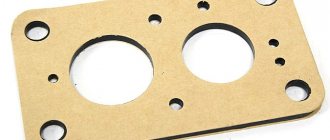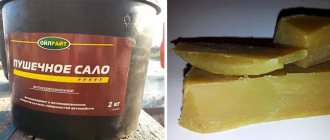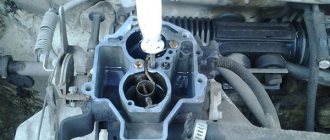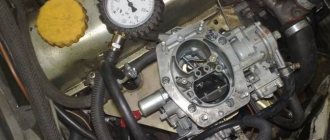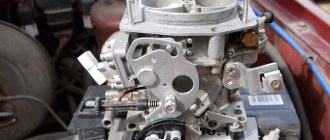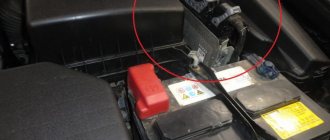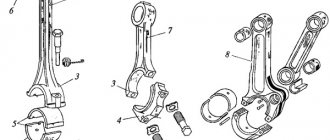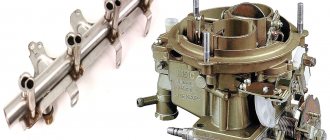As you know, you can find quite a lot of carburetor cars on domestic roads. Their main advantages are rightly considered to be affordable price, simplicity of design and maintenance, and unpretentiousness to the quality of engine oil and fuel. In parallel with this, one of the weak points of such cars is the engine power system, or more precisely, the carburetor.
We also recommend reading the article about what a carburetor dosing system is. From this article you will learn about the design, principles and features of the carburetor.
Today there are a large number of carburetor cleaning products on the market. Similar products are found in specialized auto stores, in auto goods departments in large shopping centers, at gas stations, etc. Taking into account the variety and price range, it is logical that every car owner strives to purchase a good carburetor cleaner inexpensively, which will effectively remove all contaminants without harming the dosing device. In this article we will talk about which carburetor cleaner to choose, and also answer the question of how to clean a carburetor with carburetor cleaner correctly.
Indications for cleaning
The fuel used to operate vehicles is often not of high quality.
It contains water, dirt and products that can cause corrosion. They cause pollution. Flush the carburetor in several cases:
- If lowering the power unit becomes difficult.
- If you press the accelerator pedal, there will be a delay.
- The engine does not idle well.
- You're using too much fuel.
It is worth noting that all this may indicate other vehicle malfunctions, for example, malfunctions in the ignition system. But in any case, cleaning the carburetor will be appropriate. This is especially true in cases where it has not been carried out for more than a year.
To properly wash the carburetor, you need to remember one feature. This device consists of several small parts. For some of them, rinsing will be sufficient. Others will also need to be cleaned.
With smaller elements other difficulties may arise. Take, for example, attachments with 2mm channels. Cleaning them will be problematic. In this case, it is necessary to blow with compressed air. But before that, it is better to soak the parts in some solvent. The same applies to large elements.
Some tips for choosing a cleaner
Each company that produces special auto chemicals for cleaning carburetors strives to make their products of the highest quality possible and to give them certain special characteristics. This, on the one hand, allows motorists to choose the best (in their opinion) cleaner, but, on the other hand, makes this very choice difficult. Adding to the complexity is the fact that experts do not give any special recommendations on the selection of a cleansing composition.
They advise paying attention to the fame of a particular manufacturer and the presence of favorable reviews about its products. A test of a specific cleaner, performed by professionals and posted on a specialized web resource or in a magazine for vehicle owners, can also be a good help for drivers. Very often, it is the test of several compositions under different brands that allows a person to decide which mixture he should buy.
In addition, professionals recommend choosing cleaners that do not have an overly aggressive effect on the following components of the fuel system:
- catalytic converters;
- oxygen flow sensors and other monitoring devices;
- turbochargers.
We will not give you advice on the selection of cleaning mixtures, but will simply describe those compositions that are most often purchased by domestic car owners.
Materials used
For a long time, carburetors were cleaned with a homemade cleaner.
It used to be like this:
- petrol,
- kerosene,
- DT (diesel fuel),
- any solvent.
These substances are excellent for removing all types of dirt and deposits. For maximum effect, pre-wash the carburetor.
Despite all the properties of the listed substances, it is better to use a special agent, which can be purchased at any car dealership.
There are two types of carburetor cleaning fluid. One is poured directly into the fuel tank, and the other is used to service the system. There are several illustrative examples:
- Mannol Fergazer Reiniger. This is a carburetor cleaning spray. It is also suitable for working with injectors. It effectively removes carbon deposits, oil, etc.
- Jet 100 Ultra. It has properties similar to the previous spray. It has a faster action.
- High Gear. This product can be used to clean both the fuel system and the carburetor itself. It dissolves all types of dirt and deposits well. Parts of the structure are not damaged.
The type of cleaner to be used to clean the carburetor should be selected based on its condition and when it was last cleaned.
Signs of a blockage
Clean the carburetor once a year and whenever any of the following signs of clogging appear:
- Delays occur when the accelerator pedal is pressed sharply;
- the engine is difficult to start;
- When the internal combustion engine is idling, abnormal noise occurs;
- fuel consumption has increased significantly.
Carburetor flushing fluid is also necessary for those drivers who fill their cars with low-quality gasoline containing large amounts of corrosion products and other foreign elements.
MANNOL 9970 Carburetor Cleaner
Price: 156 rub.
This inexpensive and at the same time quite high-quality product, produced by a German manufacturer, is based on a complex of highly effective organic solvents. The composition under the index 9970 successfully cleans the carburetor of carbon deposits both inside and outside. The product under the MANNOL brand is also suitable for the following devices:
- throttle valve;
- car engine;
- motorcycle chain.
Carbcleaner is applied to the surface to be cleaned by spraying. And during this process the engine can continue to run.
About types of cleaners
Carburetor cleaner can be sold as a spray or as a technical liquid. The overall condition of the cleaner determines the application method.
- sprays. They are sold in the form of small cans. Sprays are easy to apply. Spray cans come with nozzle tubes that allow you to easily reach hard-to-reach areas.
- Liquids. Supplied in plastic containers of various sizes. Does not require carburetor disassembly. Pour into the fuel tank. They are less effective than sprays. But this saves time for the car owner.
About the chemical composition
Most carburetor cleaning sprays and fluids are made from gasoline and acetone. The main differences are the presence or absence of certain additives, which depends on the manufacturer and price of the product.
For example, expensive carburetor cleaning products have additional components that slow down corrosion processes, form a protective film, lubricate moving carburetor components, etc.
Some types of agents are characterized by their versatility. For example, manufacturers assume that carburetor injector flushing will be provided. Therefore, their automotive chemicals have an optimized composition with special additives.
Methods for cleaning a carburetor
No disassembly
This method is the simplest, but the least effective. Chemically active substances (additives) that are added to the fuel are used as cleaning agents. These carburetor cleaning chemicals are simply poured into the fuel tank. The driver drives the vehicle as usual. Gasoline with the addition of an additive circulates through the fuel system, dissolving and removing dirt.
Pouring special liquids into the tank is an ineffective method. Firstly, it is not suitable for very dirty and old carburetors. Secondly, all the dissolved sediment will fall into the cylinders of the power unit, which will worsen its operation.
Thus, disinfection with carburetor cleaner, which comes in liquid form, has limited use.
Alternatively, you may want to consider using sprays that will allow you to clean this unit more effectively without having to take it apart or take it apart.
With partial disassembly
This method is most common among car enthusiasts. This is done by removing individual carburetor elements. In particular, the air filter and cover are removed, as well as all heavily soiled internal parts.
Recommended: Replacement of Lacetti valve cover gasket.
Flushing carburetor jets with this method can be replaced by blowing with a compressor.
With complete disassembly
This is the most labor-intensive and complex method, performed only by experienced drivers who know the structure of this unit of the fuel system of an internal combustion engine. After complete disassembly, the car owner can visually assess the condition and degree of contamination of the parts using a special liquid or canister to clean the carburetor.
FILL Inn FL056
Price: 169 rub.
FILL Inn is a developing brand from the Russian. Among the company's products there is also a cleaner FL056, which can effectively dissolve and wash away various contaminants from the external and internal surfaces of the carburetor. It is important that the drug is safe for paintwork.
This composition can also be used to wash a disassembled carburetor. Or for cleaning injection valves. The manufacturer himself recommends using FL056 in the following cases:
- before vehicle inspection;
- when replacing the air filter;
- during the preparation of the car for sale;
- when repairing a carburetor.
When to clean the carburetor
Unfortunately, the fuel we fill our car tanks with is not always of high quality. Dirt, corrosion products and water are mandatory components of any gasoline purchased at our gas stations. They are the cause of contamination of the device.
Signs of a blockage
Symptoms indicating a clogged carburetor include:
- Difficulty starting the power supply;
- sinks when you sharply press the accelerator pedal;
- engine malfunction at idle;
- increase in fuel consumption.
- The carburetor gets dirty not only from the inside, but also from the outside.
But here it is necessary to take into account that the listed signs may indicate other malfunctions, both in the power supply system and in the ignition system. However, if the device has not been serviced for more than a year, cleaning it will not be superfluous. In addition, before starting work, it is recommended to replace the fuel filter to be sure that after servicing the unit will run on clean gasoline.
Rinse or blow out: which is better?
A carburetor is a complex and precise device consisting of many parts. Washing alone will not be enough to remove the dirt inside some of them. Yes, the body and lid can and should be washed and cleaned if necessary.
With small details everything is a little different. Let’s take, for example, nozzles with a channel diameter of no more than 2 mm. You are unlikely to be able to wash away the dirt from there at home. The best option here would be to blow out the channels with a jet of compressed air. However, it is best to do this after these parts have been slightly acidified in one of the liquids that help dissolve the dirt. It is also recommended to soak large items before rinsing and cleaning.
Consumer Reviews
Reviews from professional auto mechanics about the above products are positive. Masters note that with the help of cleaners, cleaning takes much less time.
I have been using aerosols to clean carburetors for a long time. My work is directly related to cars, so the use of special tools allows me to significantly reduce repair time. Spray cleaners allow you to effortlessly clean dirt and carbon deposits from fuel combustion. Liqui moly is considered the most popular; it allows you not only to clean all parts, but also to lubricate all moving parts.
Car enthusiasts who prefer not to contact specialists and carry out cleaning on their own note:
Aerosols themselves are very convenient to use. After 5-10 thousand kilometers, I try to clean the carburetor to extend its service life. With modern means this is very easy to do; the nozzle helps to spray the cleaner onto the necessary parts without dismantling the carburetor.
Carburetor clogging with carbon deposits is an inevitable occurrence. Over time, they are deposited in different parts of the system, complicating its functioning. This leads to engine interruptions and uneven idling. More fuel is consumed, and the toxicity of exhaust gases increases. In such a situation, cleaning the carburetor will help. Hi-Gear carburetor cleaner will help you do this.
Washing methods and products used for it
There are three ways to wash the carburetor yourself:
- without removing the engine or disassembling it;
- from partial disassembly;
- for complete disassembly.
The first option involves adding chemically active liquids (additives) to the fuel. In other words, you need to pour a certain amount of cleaner into the tank and drive the car without wasting time. Gasoline with the additive will independently dissolve and remove dirt as it moves through the fuel system. Of course, this method cannot be called effective, and everything that we tried to get rid of inevitably ends up in the engine cylinders.
Special additives are used to clean the carburetor without disassembling it.
Flushing the carburetor using the partial disassembly method is the most popular type of maintenance. It is necessary to remove the air filter, cover, remove all elements that may be dirty, wash them and reassemble the unit. The efficiency of this method is quite high, moreover, we can visually determine how clean the unit has become.
To wash, remove the air filter and carburetor cover.
Well, if you remove and completely disassemble the device, immerse all its parts in a cleaning agent, and then wash it manually and blow it with a stream of air, you will get a practically new carburetor.
Not long ago, car owners cleaned their car's carburetors using fluids commonly found at home:
- with recycled gasoline;
- with kerosene;
- with diesel fuel;
- with solvent.
Yes, they cope quite well with various types of dirt and deposits on the internal walls of the device, especially if you have the opportunity and time to soak the necessary parts into it for a while. But today there is no need to use such means. It is better to buy a special fluid at a car dealership. There are products for sale both for self-cleaning the fuel system (filling the tank) and for servicing carburetors. The most popular and effective:
- Hi-Gear is a line of fuel system and carburetor flushing products. It has high dissolving ability. It does not damage system elements. It is available in both additive and aerosol form;
Hi-Gear additive for filling car tanks
- Mannol Vergaser Reiniger is an aerosol cleaner for carburetors. Used to clean carburetors and injectors. It copes well with soot, oil deposits and other impurities;
Carburetor cleaner “Mannol Vergaser Reiniger”
Ultra-aerosol Jet 100
How to use an aerosol cleaner
Despite the high effectiveness of this product, each owner must first learn how to clean the carburetor using this spray.
A special feature of the aerosol cleaner is that it has a special dispenser and a tube, thanks to which you can adjust the direction of the liquid when cleaning the required surface, regardless of the difficulty of accessing it. But to use this method, you will first have to completely or partially disassemble the power supply system itself. It is recommended to completely disassemble the carburetor. In this case, all the necessary conditions will be created to clean every surface of the working unit from contamination.
In order to better understand exactly how to clean this part, you should consider this process in the following steps:
- The first step is to find the fuel hoses and disconnect them from the carburetor. Next, you need to do the same with the air filter housing;
- after this they begin to clean the outer surface of the working unit;
- at this stage it is necessary to completely disassemble the case into several parts;
- the main internal elements of the power unit are cleaned, including membranes, diffusers, jets, etc.;
- The cleaning procedure is completed by installing new gaskets.
After the working unit has been cleaned, it is necessary to install new air and fuel filters. Additionally, you should check that the crankcase gas cleaning system is in working order. If this is not done immediately, then within a couple of months the carburetor will become dirty again and will require unscheduled cleaning.
How to tell if the carburetor is dirty:
- The engine runs weakly, the speed is unstable;
- Dark smoke comes out of the exhaust pipe with noise;
- Dirty spark plugs – covered with black deposits;
- Fuel consumption has increased.
Causes:
The main reason is diluted fuel. Due to impurities in fuel, soot and films of oil, paint and varnish forms that cannot be washed off with plain water and household “dishwashers”. Excessive oil or poor quality oil will also cause the fuel system to become clogged with dirt and carbon deposits over time. If there is too much oil in the intake manifold, it will clog the gauges and throttle body.
How to clean:
Do not clean with gasoline, kerosene or diesel as recommended at home! The deposits that clog the fuel system are formed from gasoline. It is necessary to use only specialized cleaners for the carburetor and throttle - “carburetors”, instead of universal cleaners, which may contain oil and silicones - will only contaminate the parts more. The most convenient means to use are aerosols. During cleaning, thanks to the pressure of the spray bottle, they wash away dirt and carbon deposits. Parts can be cleaned without removing them. There are also means for self-cleaning the carburetor system - liquid additives in jars or canisters. They are poured into the fuel tank and then into the carburetor, where they remove deposits and dirt. This “express cleaning” will not completely remove dirt and is considered an emergency measure at home. Cleaning with an aerosol cleaner will take another 10 minutes, but you will see immediate results.
How to clean:
When manually cleaning with aerosol
– Remove the air filter and spray a product such as
carbohydrate cleaner
Target – one in the carburetor, throttle valve and float chamber. The dirt will begin to dissolve after a few minutes. If the parts remain dirty, repeat the procedure a maximum of 2 times. Start the engine and warm it up at idle speed for about 5-7 minutes. While the engine is running, apply the product to the carburetor cavities, coils and other parts of the fuel system. Stop the engine and continue spraying cleaner after it has stopped for 5-10 seconds. Then adjust the idle speed. Do nothing else - do not clean or rinse with water. Reinstall the air filter.
Self-cleaning liquid detergent
– pour the product into the fuel tank.
Refuel. The cleaner is mixed with fuel and enters the carburetor while the engine is running. As the fuel burns, the cleaner comes into action and partially cleans the parts. Manual cleaning with carburetor removal and disassembly
- Remove the carburetor and disassemble it. Place the rubber parts separately - the cleaner should not come into contact with them. Spray the cleaner in an aerosol spray onto the metal parts. If the carburetor has not been cleaned for a long time, and its parts are covered with a thick layer of deposits, put it in a container and fill it with liquid cleaner, leave it overnight or so. Then take it out and wipe it thoroughly with a brush. Blow out the cavities using a can of compressed air and dry them at the same time. When assembling the carburetor, keep the owner's manual or assembly instructions handy. Adjust the idle speed, throttle and, if necessary, the carburetor float mechanism.
Important Tips
After the carburetor has been cleaned, it must be reassembled in the same order. During disassembly, you must immediately remember where the fuel and air jets were located. In addition, the float chamber level and idle speed should be adjusted.
Considering this opportunity, after cleaning the power system unit, you should check the condition of the fuel pump and fuel tank. Some vehicles may have a mechanical fuel pump. It also needs to be checked and, if necessary, cleaned with an aerosol cleaner. If this is not done immediately, then very soon the dust present on the membrane and valves of the pump may again enter the carburetor and lead to new blockages.
To restore the fuel tank to proper condition, it will first have to be dismantled. Experts also recommend regularly cleaning this unit, since a lot of dirt often accumulates in it due to the use of low-quality gasoline. Subsequently, the sediment formed in the fuel tank can penetrate into the carburetor, and this happens with enviable regularity, even though fuel enters it through the fuel filter and the float chamber mesh.
To bring the fuel system into working condition, it is necessary to clean all key elements, starting with the gas tank and ending with the carburetor. Using an integrated approach will ensure stable engine operation and normalize fuel consumption.
The best carburetor cleaners
- Vergaser-Aussen-Reiniger from Liqui Moly. The best carburetor cleaner for medium to heavy fouling is available in 0.4 liter cans. It helps remove colored oxides, carbon deposits, etc. The kit includes a long spray hose.
- Carb Reiniger Spray from Ravenol. Carb Reiniger Spray effectively removes soot, tar, paint deposits, etc. Suitable for cleaning exhaust valves and carburetor passages, throttle valves, jets, etc.
- PN0 8796 on 3M. Carburetor and throttle valve cleaner. Also suitable for removing contaminants from the intake tract temperature sensor and the forced crankcase ventilation system. Removes soot deposits well.
RAVENOL Carb Reiniger Spray
Price: 744 rub.
The product, produced by the German manufacturer RAVENOL, is capable of quickly and efficiently cleaning carbon deposits, carbon deposits, resins, as well as the varnish layer from car parts related to the carburetor, and not only. It can be:
- throttle valve;
- carburetor jets and channels;
- idle air system and valve;
- intake valves;
- piston heads.
The basis of the German cleaner is toluene and alcohol, diluted with a propane-isobutane mixture. The product is applied to the surface to be treated by spraying.
Care products
A couple of decades ago, domestic car owners did not have the opportunity to use liquids to clean the fuel system. They had to make do with more affordable means such as diesel fuel, kerosene, thinner and acetone. These materials were very affordable, allowing every car enthusiast to operate a carburetor at minimal cost.
Any modern spray for cleaning carburetors is an order of magnitude more effective than those compounds that were available in the past. And first of all, this shows their excellent quality.
Types of cleaning compositions
Car owners have no particular problems with washing the carburetor at home. Today there are two types of cleaners:
- aerosol cleaner;
- a special liquid poured into the tank, where it is mixed with fuel.
Before using the spray cleaner, the operating unit must be completely disassembled. In this case, a higher efficiency of the procedure is guaranteed. In the second case, when using a special liquid, there is no need to carry out such complex manipulations. The cleaning composition is simply poured into the gas tank, where, after mixing with fuel, it appears in the carburetor, simultaneously removing all contaminants from the internal walls. The dirt then enters the combustion chamber and exits through the exhaust pipe.
Tips for choosing
In order not to make a mistake when choosing a detergent, you must follow some rules:
- It is recommended to choose compounds containing more active components for washing. This directly affects their effectiveness.
- Preference should be given to liquids from well-known manufacturers. Popular brands are Liqui Moly, Mannol and Hi-Gear.
- Before you go to the store for cleaning fluid, it doesn't hurt to read reviews from other car owners who have extensive experience cleaning the carburetor first.
Precautionary measures should not be neglected. Aerosol cleaners contain many flammable ingredients that can cause a fire hazard if not handled properly. It is also necessary to take into account that such liquids have a specific odor. It is therefore recommended that this equipment be cleaned not only away from sources of fire, but also in conditions of good ventilation.
Is it possible to wash it at home without special products?
If you do not have the opportunity to use special carburetor cleaning products, you can do it without them. Simply soak the necessary parts in kerosene (gasoline, acetone) overnight and start cleaning and cleaning them in the morning. With the right approach, the effect will not be worse. But under no circumstances follow the advice of “experts” who recommend pouring acetone into the tank or carburetor to clean the fuel system! Yes, acetone is great for dissolving and removing dirt, grime, paint residue and even water. But it also dissolves plastic and rubber seals, gaskets and valves!
As you can see, washing a carburetor with your own hands is not at all difficult. The main thing is to have a good cleaner, the necessary tools and a few hours of free time. And to prevent this process from becoming habitual, fill only high-quality fuel into the tank of your car.
Carburetor for VAZ 2106 and 2107: troubleshooting, manual repair, installation, adjustment.
How to correctly evaluate the functionality of shock absorber struts
Features of using the cleaning product
How to use carburetor cleaner? Let's start with an example of an aerosol with a complete disassembly of this device. Carburetor cleaner added to the fuel tank is not suitable for this procedure.
The cleaning process consists of the following steps:
- to remove the carburetor;
It is best to place this internal combustion system assembly on a workbench that has been pre-treated with dust. Remove any foreign objects that may interfere with cleaning.
- disassembly in parts;
It is important that the carburetor is cleaned in a well-lit, convenient place. All parts must be disassembled and neatly placed next to each other. Be careful while working; all small items (springs, needles, etc.) should be placed separately so that nothing gets lost.
- product application;
Aerosol carburetor cleaner should be carefully sprayed onto the surface of contaminated parts. Wait a while to allow the cleaner to react with the dirt. This period is specified in the operating instructions.
- cleaning with a cloth;
Use a rag to remove the agent that has reacted with dust, dirt and deposits. Modern aerosols do a good job of dissolving plaque and other contaminants. Therefore, there should be no difficulty in performing this procedure.
High-quality cleaning of hard-to-reach places is carried out by spraying an aerosol using a special hose included in the delivery set.
Please note that rubber and plastic parts must be cleaned separately from other parts. The aggressive chemical composition of such a carbon cleaner can deform them.
- drying and air blowing;
These cleaning steps will ensure the most effective results. If a quality product is used, the driver will receive a practically new carburetor.
- installation of the device.
The carburetor must then be carefully reassembled and reinstalled.
Instructions for use
The algorithm of action when working with aerosols is approximately the same. In most cases, dismantling the carburetor is required. Step-by-step carb cleaning:
- remove the carb and disassemble;
- a cleaner is applied to the surface of each part;
- leave the sprayed parts for 5-10 minutes;
- Use a brush or rag to remove soaked carbon deposits.
Cleaning the carburetor is a simple task. When carrying out this kind of event, it is important not to lose parts of the mechanism.
How to make a carburetor cleaner with your own hands?
If you want, you can make your own cleaner. The composition of the carburetor cleaner will include the following components:
- Acetone.
- Gasoline with solvent (“Galosh”).
- White Spirit.
These liquids should be mixed in the same proportion (about 33%). The finished carb cleaner has an affordable price. The metal parts of the carburetor must be immersed in this composition.
Can this cleaner be used instead of disinfectant with professional automotive chemicals? Yes, with the exception of heavily polluted internal combustion engines.
Other washing methods
Sometimes there is no special cleaner for the control panel nearby. In these cases, solvent No. 646 can help. However, don't rely on it too much. The efficiency of this cleaning method is quite low; moreover, it is able to remove dirt from the surface of the carburetor only for a short time.
The proper functioning of this part depends not only on how often it is cleaned, but also on the product used. In order not to make a mistake when choosing this product, you need to carefully read in the store about its composition and properties. It is imperative to consider the activities involved in using the cleaning product. In addition, we should not forget that all elements of the fuel system must be cleaned regularly. To ensure proper functioning of the carburetor, it is recommended to clean it every 10-15 thousand kilometers.
Trouble-free operation of a car depends on many components, not the least of which is the carburetor. Every car owner should regularly check its condition. This is especially true for those who use low-quality fuel. This factor increases the likelihood of clogging by an order of magnitude. But you can avoid the negative consequences caused by a dirty carburetor if you clean it regularly.
Every car owner can handle this task with his own hands, so you don’t even have to turn to specialists for help. Only when disassembling this power supply is it necessary to remember the location of the main parts. But first you need to understand the best way to flush the carburetor.
This must be a special composition designed to remove contaminants from the internal and external surfaces of the working unit. It is not recommended to save on the purchase of cleaning fluid, otherwise this may soon cause new, even more serious problems for the car enthusiast, which will require not only more time, but also greater financial costs.
What's the result?
Considering all of the above, it is obvious that even with the relative simplicity of the carburetor design, it still requires additional timely maintenance. To keep the unit clean and in good working order, some experts recommend cleaning and adjusting the carburetor at least twice a year. It is recommended to do this in the off-season, that is, before the onset of severe frosts or warm weather. This measure allows you to maintain fuel consumption at an optimal level.
If you notice noticeable sagging when you press the accelerator pedal, then in parallel with cleaning the carburetor itself, remove the carburetor cover, and then pay attention to the accelerator pump nozzle. This element must be thoroughly cleaned with a carbon cleaner; in addition, it can be blown with compressed air from a compressor.
It should also be added that cleaning without dismantling and disassembling using various cleaners is more effective in case of downtime problems, and also helps to externally clean the surfaces of the carburetor itself from dirt.
In other situations, it is best to disassemble and clean the dispenser as quickly as possible. This also applies if the carburetor is for some reason very dirty or has never been cleaned before.
Symptoms of pollution
Every owner should know when to start worrying and flush the carburetor. The critical state of this element can be determined by a number of characteristic features:
- significant dips during sudden acceleration and delayed response when pressing the accelerator pedal;
- unstable idling, speed becoming floating;
- difficulty starting a cold or hot engine;
- presence of high toxicity and smoke;
- significant reduction in power and increased fuel consumption.
Unfortunately, it is not always possible to say that the source of the problem is the carburetor when the above symptoms appear. Therefore, in such cases, it is imperative to first carry out a full diagnostics of the engine. Only after this can you start thinking about how to clean the carburetor.
If you constantly monitor the condition of this unit and regularly clean it, this will subsequently allow you to avoid many unpleasant moments, including unnecessary financial expenses and loss of time due to vehicle downtime.
Owners who neglect to wash this unit in a timely manner often experience the symptoms described above. In especially severe cases, when it is heavily clogged, dust and dirt as a result of vacuum may even end up inside the cylinder, and this can lead to the appearance of scuff marks on its mirror and carbon deposits on the surface of the piston.
